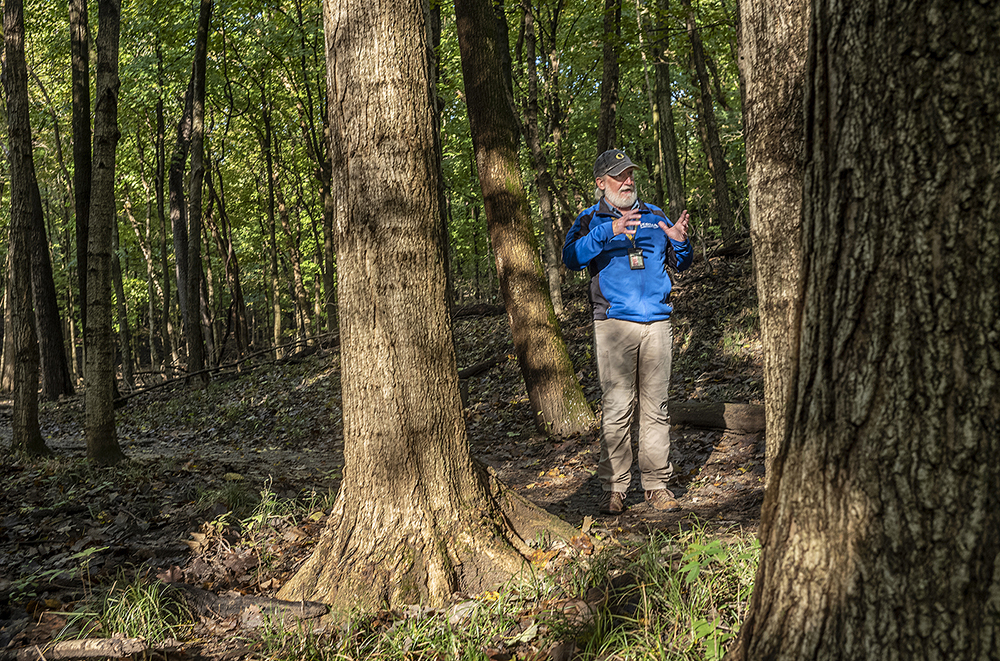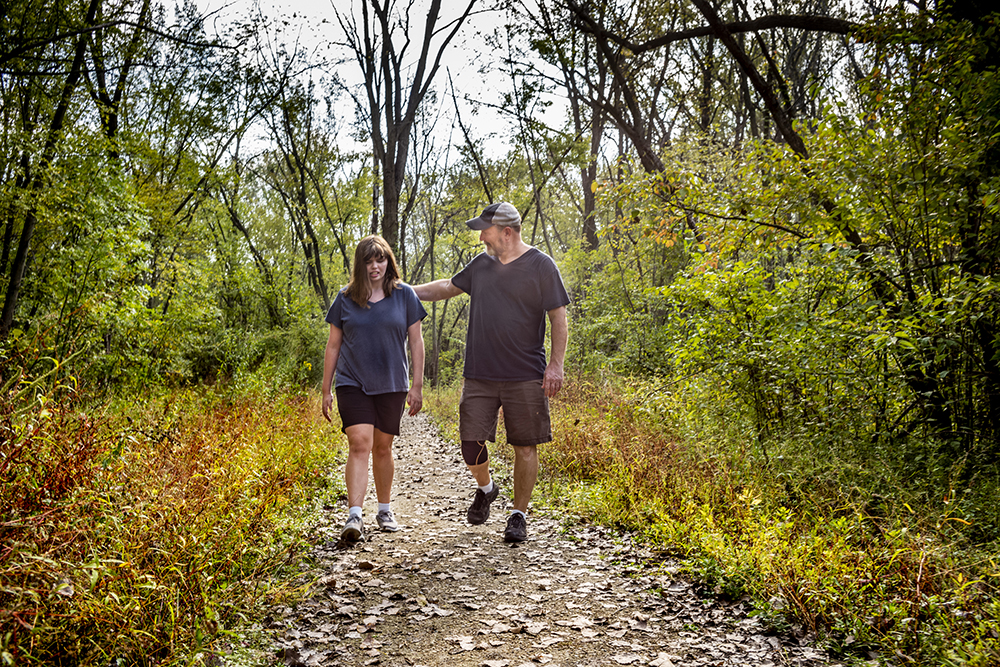
Mike Miller, supervisor of environmental and interpretive services at the Peoria Park District, pauses at the start of Wilderness Trail at Forest Park Nature Center and says the property will remain accessible to the public following its purchase by Peoria Park District. (PHOTO BY DAVID ZALAZNIK)
One of the most cherished parks in central Illinois was owned for nearly 70 years by the private Forest Park Foundation under the leadership of three generations of the Rutherford family.
As the foundation began to wind down operations, it started work to ensure Forest Park remain open to the public by crafting a sale to the Peoria Park District. The park district was able to close on the purchase of Forest Park Nature Center in late September.
Conservationists and environmentalists are delighted.
First acquired by Forest Park Foundation in the early 1950s, the land was designated a nature preserve in 1964, one of only a dozen nature preserves in the entire state at that time.
While the nature preserve designation meant the park, now more than 500 acres, was protected from development, it did not guarantee public access. The land could have been sold to a person or organization and it would still have to be a nature preserve in perpetuity, but it could legally have been closed to public access.
Attorney Jim Tomlin, legal counsel for Forest Park Foundation, oversaw the transfer of ownership following a model used by William Rutherford Sr., second generation family leader. With that model, the foundation agreed to sell Forest Park Nature Center to the park district for $1 million and urged the park district to apply for a grant from the Open Lands Program, and the foundation agreed to match that funding.
With the $500,000 grant and $500,000 in other funding, the park district purchased the property. The foundation then gave $500,000 to the park district Legacy Fund dedicated to maintenance of parklands.
“As we near the end of the life of Forest Park Foundation, it was very important this transaction was structured this way. Forest Park Foundation as an entity will not go on forever,” Tomlin said.
He is satisfied the goals of the foundation are met and cited Forest Park Nature Center, Wildlife Prairie Park, beautification of Peoria Heights, donations to Springdale Cemetery and countless other parks and acreages the foundation has supported over the past 70 years.
Mike Miller, supervisor of environmental and interpretive services at the Peoria Park District, considers the transfer of ownership a significant and lasting legacy for the Peoria area.
“This will now be a public park in perpetuity. That’s important for the entire community,” Miller said.
While the Chicago area has land trusts, conservation districts, forest preserves and nature preserves, it was Forest Park Foundation that brought all those benefits to the Peoria area, he said.
“The foundation was performing like a land trust before the term was even coined.”
Over the years, the park district had to carefully monitor spending on the building and trails in the park because it did not own the property. The purchase now means the Nature Center has a permanent endowment. The museum has already been renovated and upgraded with new displays and an 18-foot model of a Chinquapin Oak tree, considered a hallmark tree of the central Illinois river bluffs.
Curb cuts, sidewalks and other upgrades will provide greater accessibility.
Hydrology in the park is closely linked to development in the watershed area. The park gets runoff from roads, homes and commercial development.
“Maintaining a healthy watershed is complicated,” Miller said. “We have to deal with what comes from upstream.”
Maintaining the health of the forest is a critical component of the health of the watershed. Lasting remediation does not come from one creek or one parcel of property but must involve solutions throughout the watershed, he said, noting that in an ideal world, development would only occur when creeks and streams are maintained and considered an integral part of the Good of the Commons.
Today, the Peoria Park District has about 1,600 acres of nature preserve and 9,000 acres of park district property.
“This transfer of ownership should be a seamless transition for the public, but it means this property remains a nature preserve with public access into the future. That was never guaranteed before,” Miller said.
“So many people have said to me during the pandemic that if not for the trails and nature, they might not have made it to the other side. Parks pull us all through this. Getting through the pandemic has heightened our sense of responsibility and stewardship.”
He reflected that every generation goes through periods of turmoil and inner reflection.
“My generation is getting older, and it’s important to tell the story and pass on the lessons learned from the foundation and from leaders like George Fell (founder of the Natural Land Institute) and Bill Rutherford.”

Photojournalist Matt Dayhoff walks regularly with his daughter Jillian who has severe and profound autism. She is non-verbal and emotionally unpredictable, but Matt observes the calmness Jillian often finds walking in nature. The two love Forest Park Nature Center in Peoria Heights. She also loves the trail and boardwalk above at Cooper Park along the Illinois River in East Peoria. Parks and trails throughout the Peoria area are a beautiful an invaluable resource for the Dayhoff family. Nature can help with the challenges and complications of raising a child with special needs. (PHOTO BY DAVID ZALAZNIK)

Recent Comments